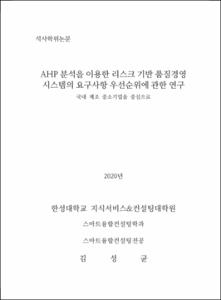AHP 분석을 이용한 리스크 기반 품질경영 시스템의 요구사항 우선순위에 관한 연구
= A Study on the Requirements Priority of Risk-Based Quality Management System Using AHP Analysis Focusing on on domestic manufacturing SMEs
- Type
- Thesis
- Alternative Title
- 국내 제조 중소기업을 중심으로
- Department
- 지식서비스&컨설팅대학원 스마트융합컨설팅학과
- Issued Date
- 2020
- Publisher
- 한성대학교 대학원
- Keyword
- 품질경영시스템; ISO 9001:2015; 리스크기반; 리스크 관리; AHP
- Appears in Collections:
- 스마트융합컨설팅학과 > 1. Thesis
- Files in This Item:
-
-
Download
 200000333841.pdf
기타 데이터 / 1.52 MB / Adobe PDF
200000333841.pdf
기타 데이터 / 1.52 MB / Adobe PDF
-
Items in Repository are protected by copyright, with all rights reserved, unless otherwise indicated.